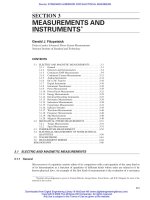Electromagnetism for electronic engineers (malestrom)
Bạn đang xem bản rút gọn của tài liệu. Xem và tải ngay bản đầy đủ của tài liệu tại đây (4.89 MB, 158 trang )
Malestrom
1
Richard. G Cart er
Elect rom agnet ism for
Elect ronic Engineers
2
Elect rom agnet ism for Elect ronic Engineers
© 2009 Richard. G Cart er & Vent us Publishing ApS
I SBN 978- 87- 7681- 465- 6
3
Electromagnetism for Electronic Engineers
Contents
Cont ent s
Preface
8
1.
1.1
1.2
1.3
1.4
1.5
1.6
1.7
1.8
1.9
1.10
1.11
1.12
Electrostatics in free space
The inverse square law of force between two electric charges
The electric Þeld
Gauss’ theorem
The differential form of Gauss’ theorem
Electrostatic potential
Calculation of potential in simple cases
Calculation of the electric Þeld from the potential
Conducting materials in electrostatic Þelds
The method of images
Laplace’s and Poisson’s equations
The Þnite difference method
Summary
10
11
12
14
17
18
20
22
24
27
28
29
32
2.
2.1
2.2
2.3
2.4
2.5
2.6
2.7
2.8
2.9
Dielectric materials and capacitance
Insulating materials in electric Þelds
Solution of problems involving dielectric materials
Boundary conditions
Capacitance
Electrostatic screening
Calculation of capacitance
Energy storage in the electric Þeld
Calculation of capacitance by energy methods
Finite element method
33
34
37
38
40
40
43
44
46
47
4
Electromagnetism for Electronic Engineers
References
2.10
2.11
Boundary element method
Summary
49
49
3.
3.1
3.2
3.3
3.4
3.5
3.6
3.7
3.8
Steady electric currents
Conduction of electricity
Ohmic heating
The distribution of current density in conductors
Electric Þelds in the presence of currents
Electromotive force
Calculation of resistance
Calculation of resistance by energy methods
Summary
50
50
52
53
56
56
58
59
59
4.
4.1
4.2
4.3
4.4
4.5
4.6
The magnetic effects of electric currents
The law of force between two moving charges
Magnetic ßux density
The magnetic circuit law
Magnetic scalar potential
Forces on current-carrying conductors
Summary
60
60
61
65
66
68
68
5.
5.1
5.2
5.3
5.4
5.5
5.6
5.7
The magnetic effects of iron
Introduction
Ferromagnetic materials
Boundary conditions
Flux conduction and magnetic screening
Magnetic circuits
Fringing and leakage
Hysteresis
69
70
70
74
75
77
79
81
WHAT‘S MISSING IN THIS EQUATION?
You could be one of our future talents
5
Electromagnetism for Electronic Engineers
References
5.8
5.9
5.10
5.11
Solution of problems in which cannot be regarded as constant
Permanent magnets
Using permanent magnets efÞciently
Summary
84
85
87
88
6.
6.1
6.2
89
89
89
6.4
6.5
6.6
6.7
6.8
6.9
6.10
6.11
6.12
6.13
6.14
6.15
Electromagnetic induction
Introduction
The current induced in a conductor moving through a steady
magnetic Þeld
The current induced in a loop of wire moving through a
non-uniform magnetic Þeld
Faraday’s law of electromagnetic induction
Inductance
Electromagnetic interference
Calculation of inductance
Energy storage in the magnetic Þeld
Calculation of inductance by energy methods
The LCRZ analogy
Energy storage in iron
Hysteresis loss
Eddy currents
Real electronic components
Summary
7.
7.1
7.2
7.3
7.4
Transmission lines
Introduction
The circuit theory of transmission lines
Representation of waves using complex numbers
Characteristic impedance
116
116
117
121
122
6.3
6
82
93
95
98
101
104
107
107
110
112
113
115
115
Electromagnetism for Electronic Engineers
References
7.5
7.6
7.7
7.8
7.9
7.10
7.11
7.12
7.13
Reßection of waves at the end of a line
Pulses on transmission lines
Reßection of pulses at the end of a line
Transformation of impedance along a transmission line
The quarter-wave transformer
The coaxial line
The electric and magnetic Þelds in a coaxial line
Power ßow in a coaxial line
Summary
123
126
128
131
133
134
135
137
138
8.
8.1
8.2
8.3
8.4
8.5
8.6
8.7
8.9
Maxwell’s equations and electromagnetic waves
Introduction
Maxwell’s form of the magnetic circuit law
The differential form of the magnetic circuit law
The differential form of Faraday’s law
Maxwell’s equations
Plane electromagnetic waves in free space
Power ßow in an electromagnetic wave
Summary
140
140
140
142
145
146
148
151
151
Bibliography
152
Appendix
155
Brain power
By 2020, wind could provide one-tenth of our planet’s
electricity needs. Already today, SKF’s innovative knowhow is crucial to running a large proportion of the
world’s wind turbines.
Up to 25 % of the generating costs relate to maintenance. These can be reduced dramatically thanks to our
systems for on-line condition monitoring and automatic
lubrication. We help make it more economical to create
cleaner, cheaper energy out of thin air.
By sharing our experience, expertise, and creativity,
industries can boost performance beyond expectations.
Therefore we need the best employees who can
meet this challenge!
The Power of Knowledge Engineering
Plug into The Power of Knowledge Engineering.
Visit us at www.skf.com/knowledge
7
Electromagnetism for Electronic Engineers
Preface
Preface
Electromagnetism is fundamental to the whole of electrical and electronic engineering. It provides the
basis for understanding the uses of electricity and for the design of the whole spectrum of devices
from the largest turbo-alternators to the smallest microcircuits. This subject is a vital part of the
education of electronic engineers. Without it they are limited to understanding electronic circuits in
terms of the idealizations of circuit theory.
The book is, first and foremost, about electromagnetism, and any book which covers this subject must
deal with its various laws. But you can choose different ways of entering its description and still, in
the end, cover the same ground. I have chosen a conventional sequence of presentation, beginning
with electrostatics, then moving to current electricity, the magnetic effects of currents,
electromagnetic induction and electromagnetic waves. This seems to me to be the most logical
approach.
Authors differ in the significance they ascribe to the four field vectors E, D, B and H. I find it
simplest to regard E and B as ‘physical’ quantities because they are directly related to forces on
electric charges, and D and H as useful inventions which make it easier to solve problems involving
material media. For this reason the introduction of D and H is deferred until the points at which they
are needed for this purpose.
Secondly, this is a book for those whose main interest is in electronics. The restricted space available
meant that decisions had to be taken about what to include or omit. Where topics, such as the force on
a charged particle moving in vacuum or an iron surface in a magnetic field, have been omitted, it is
because they are of marginal importance for most electronic engineers. I have also omitted the chapter
on radio-frequency interference which appeared in the second edition despite its practical importance.
Thirdly, I have written a book for engineers. On the whole engineers take the laws of physics as
given. Their task is to apply them to the practical problems they meet in their work. For this reason I
have chosen to introduce the laws with demonstrations of plausibility rather than formal proofs. It
seems to me that engineers understand things best from practical examples rather than abstract
mathematics. I have found from experience that few textbooks on electromagnetism are much help
when it comes to applying the subject, so here I have tried to make good that deficiency both by
emphasizing the strategies of problem-solving and the range of techniques available. A companion
volume is planned to provide worked examples.
Most university engineering students already have some familiarity with the fundamentals of
electricity and magnetism from their school physics courses. This book is designed to build on that
foundation by providing a systematic treatment of a subject which may previously have been
encountered as a set of experimental phenomena with no clear links between them. Those who have
not studied the subject before, or who feel a need to revise the basic ideas, should consult the
elementary texts listed in the Bibliography.
8
Electromagnetism for Electronic Engineers
Preface
The mathematical techniques used in this book are all covered either at A-level or during the first year
at university. They include calculus, coordinate geometry and vector algebra, including the use of dot
and cross products. Vector notation makes it possible to state the laws of electromagnetism in concise
general forms. This advantage seems to me to outweigh the possible disadvantage of its relative
unfamiliarity. I have introduced the notation of vector calculus in order to provide students with a
basis for understanding more advanced texts which deal with electromagnetic waves. No attempt is
made here to apply the methods of vector calculus because the emphasis is on practical problemsolving and acquiring insight and not on the application of advanced mathematics.
I am indebted for my understanding of this subject to many people, teachers, authors and colleagues,
but I feel a particular debt to my father who taught me the value of thinking about problems ‘from
first principles’. His own book, The Electromagnetic Field in its Engineering Aspects (2nd edn,
Longman, 1967) is a much more profound treatment than I have been able to attempt, and is well
worth consulting.
I should like to record my gratitude to my editors, Professors Bloodworth and Dorey, of the white and
red roses, to Tony Compton and my colleague David Bradley, all of whom read the draft of the first
edition and offered many helpful suggestions. I am also indebted to Professor Freeman of Imperial
College and Professor Sykulski of the University of Southampton for pointing out mistakes in my
discussion of energy methods in the first edition.
Finally, I now realize why authors acknowledge the support and forbearance of their wives and
families through the months of burning the midnight oil, and I am most happy to acknowledge my
debt there also.
Richard Carter
Lancaster 2009
9
Electromagnetism for Electronic Engineers
1. Electrostatics in free space
1. Elect rost at ics in free space
Objectives
To show how the idea of the electric field is based on the inverse square law of force between
two electric charges.
To explain the principle of superposition and the circumstances in which it can be applied.
To explain the concept of the flux of an electric field.
To introduce Gauss’ theorem and to show how it can be applied to those cases where the
symmetry of the problem makes it possible.
To derive the differential form of Gauss’ theorem.
To introduce the concept of electrostatic potential difference and to show how to calculate it
from a given electric field distribution.
To explain the idea of the gradient of the potential and to show how it can be used to calculate
the electric field from a given potential distribution.
To show how simple problems involving electrodes with applied potentials can be solved
using Gauss’ theorem, the principle of superposition and the method of images.
To introduce the Laplace and Poisson equations.
To show how the finite difference method can be used to find the solution to Laplace’s
equation for simple two-dimensional problems.
10
Electromagnetism for Electronic Engineers
1. Electrostatics in free space
1.1 The inverse square law of force bet ween t wo elect ric charges
The idea that electric charges exert forces on each other needs no introduction to anyone who has ever
drawn a comb through his or her hair and used it to pick up small pieces of paper. The existence of
electric charges and of the forces between them underlies every kind of electrical or electronic device.
For the present we shall concentrate on the forces between charges which are at rest and on the force
exerted on a moving charge by other charges which are at rest. The question of the forces between
moving charges, which is a little more difficult, is dealt with in Chapter 4.
The science of phenomena involving stationary electric charges, known as electrostatics, finds many
applications in electronics, including the calculation of capacitance and the theory of every type of
active electronic device. Electrostatic phenomena are put to work in electrostatic copiers and paint
sprays. They can also be a considerable nuisance, leading to explosions in oil tankers and the need for
special precautions when handling metal-oxide semiconductor integrated circuits.
The starting point for the discussion of electrostatics is the experimentally determined law of force
between two concentrated charges. This law, first established by Coulomb (1785), is that the force is
proportional to the product of the magnitudes of the charges and inversely proportional to the square
of the distance between them. In the shorthand of mathematics the law may be written
F
Q1Q2
rˆ
4 0r 2
(1.1)
where Q1 and Q2 are the magnitudes of the two charges and r is
the distance between them, as shown in the figure on the right.
Now force is a vector quantity, so Equation (1.1) includes the
unit vector rˆ which is directed from Q1 towards Q2 and the
equation gives the force exerted on Q2 by Q1. The force exerted
on Q1 by Q2 is equal and opposite, as required by Newton’s
third law of motion.
Examination of Equation (1.1) shows that it includes the effect of the polarity of the charges correctly,
so that like charges repel each other while unlike charges attract. The symbol 0 denotes the primary
electric constant; its value depends upon the system of units being used. In this book SI units are
used throughout, as is now the almost universal practice of engineers. In this system of units 0 is
measured in Farads per metre, and its experimental value is 8,854 × l0-12 F m-1; the SI unit of charge is
the coulomb (C).
11
Electromagnetism for Electronic Engineers
1. Electrostatics in free space
Electric charge on a macroscopic scale is the result of the accumulation of large numbers of atomic
charges each having magnitude 1.602 × l0-19 C. These charges may be positive or negative, protons
being positively charged and electrons negatively. In nearly all problems in electronics the electrons
are movable charges while the protons remain fixed in the crystal lattices of solid conductors or
insulators. The exceptions to this occur in conduction in liquids and gases, where positive ions may
contribute to the electric current.
1.2 The elect ric field
Although Equation (1.1) is fundamental to the theory of electrostatics it is seldom, if ever, used
directly. The reason for this is that we are usually interested in effects involving large numbers of
charges, so that the use of Equation (1.1) would require some sort of summation over the (vector)
forces on a charge produced by every other charge. This is not normally easy to do and, as we shall
see later, the distribution of charges is not always known, though it can be calculated if necessary.
Equation (1.1) can be divided into two parts by the introduction of a new vector E, so that
E
Q1
4
and F
rˆ
(1.2)
Q2 E
(1.3)
2
0r
The vector E is known as the electric field, and is measured in volts per metre in SI units. The step of
introducing E is important because it separates the source of the electric force (Q1) from its effect on
the charge Q2. The question of whether the electric field has a real existence or not is one which we
can leave to the philosophers of science; its importance to engineers is that it is an effective tool for
solving problems.
The electric field is often represented by diagrams like Fig. 1.1 in which the lines, referred to as ‘lines
of force’, show the direction of E. The arrowheads show the direction of the force which would act on
a positive charge placed in the field. The spacing of the lines of force is close where the field is strong
and wider where it is weak. This kind of diagram is a useful aid to thought about electric fields, so it is
well worth while becoming proficient in sketching the field patterns associated with different
arrangements of charges. We shall return to this point later, when discussing electric fields in the
presence of conducting materials.
12
Electromagnetism for Electronic Engineers
1. Electrostatics in free space
Fig.1.1 The electric field of a point charge can be represented diagrammatically by lines of force. The
figure should really be three-dimensional, with the lines distributed evenly in all directions.
In order to move from the idea of the force acting between two point charges to that acting on a charge due to
a whole assembly of other charges it is necessary to invoke the principle of superposition. This principle
applies to any linear system, that is, one in which the response of the system is directly proportional to the
stimulus producing it. The principle states that the response of the system to a set of stimuli applied
simultaneously is equal to the sum of the responses produced when the stimuli are applied separately.
Equation (1.2) shows that the electric field in the absence of material media (‘in free space’) is proportional
to the charge producing it, so the field produced by an assembly of charges is the vector sum of the fields
due to the individual charges. The principle of superposition is very valuable because it allows us to tackle
complicated problems by treating them as the sums of simpler problems. It is important to remember that
the principle can be applied only to linear systems. The response of some materials to electric fields is nonlinear and the use of the principle is not valid in problems involving them.
13
Electromagnetism for Electronic Engineers
1. Electrostatics in free space
Before discussing ways of calculating the electric field it is worth noting why we might wish to do it.
The information might be needed to calculate:
the forces on charges;
the conditions under which voltage breakdown might occur;
capacitance;
the electrostatic forces on material media.
The last of these is put to use in electrostatic loudspeakers, copiers, ink-jet printers and paint sprays
and is of growing importance in micro-mechanical devices.
1.3 Gauss' t heorem
Figure 1.1 shows electric field lines radiating from a charge in much the same way that flow lines in
an incompressible fluid radiate from a source (such as the end of a thin pipe) immersed in a large
volume of fluid (shown in Fig. 1.2). Now in the fluid the volume flow rate across a control surface
such as S, which encloses the end of the pipe, must be independent of the surface chosen and equal to
the flow rate down the pipe, that is, to the strength of the source.
Fig. 1.2 The flow of an incompressible fluid from the end of a thin pipe is analogous to the electric
field of a point charge. It is necessary for the end of the pipe to be well away from the surface of the
fluid and the walls of the containing vessel
To apply this idea to the electric field it is necessary to define the
equivalent of the flow rate which is known as the electric flux. The figure
on the right shows a small element of surface of area dA and the local
direction of the electric field E. The flux of E through dA is defined as the
product of the area with the normal component of E. This can be written
very neatly using vector notation by defining a vector dA normal to the
surface element. The flux of E through dA is then just E·dA = E dA cos .
14
Electromagnetism for Electronic Engineers
1. Electrostatics in free space
Now consider the total flux coming from a point charge. The simplest choice of control surface
(usually called a Gaussian surface in this context) is a sphere concentric with the charge. Equation
(1.2) shows that E is always normal to the surface of the sphere and its magnitude is constant there.
This makes the calculation of the flux of E out of the sphere easy - it is just the product of the
magnitude of E with the surface area of the sphere:
flux of E
Q
4
0
r
2
4 r2
Q
(1.4)
0
Thus the flux of E out of the sphere is independent of the radius of the sphere and depends only on the
charge enclosed within it. It can be shown that this result is true for any shape of surface and, by using
the principle of superposition, for any grouping of charges enclosed. The result may be stated in
words:
The flux of E out of any closed surface in free space is equal to the charge enclosed by the surface
divided by 0.
This is known as Gauss’ theorem. It can also be written, using the notation of mathematics, as
E.dA
S
1
dv
(1.5)
0 V
where S is a closed surface enclosing the volume V and is the charge density within it. Equation
(1.5) looks fearsome but, in fact, it is possible to apply it directly only in three cases whose symmetry
allows the integrals to be evaluated. Those cases are:
Parallel planes
Concentric cylinders
Concentric spheres
To show how this is done let us consider the case of a long, straight, rod of radius a carrying a
uniform charge q per unit length. From the symmetry of the problem we can assume that E is
everywhere directed radially outwards and that the magnitude of E depends only on the distance from
the axis. This is not valid near the ends of the rod but the problem can be solved in this way only if
this assumption is made. The next step is to define the Gaussian surface to be used. This is chosen to
be a cylinder of radius r and unit length concentric with the charged cylinder with ends which are flat
and perpendicular to the axis as shown in Fig. 1.3
15
Electromagnetism for Electronic Engineers
1. Electrostatics in free space
Fig. 1.3 A Gaussian surface for calculating the electric field strength around a charged rod.
On the curved part of the Gaussian surface E has constant magnitude and is everywhere perpendicular
to the surface. The flux of E out of this part of the surface is therefore equal to the product of E and
the area of the curved surface. On the ends of the cylinder E is not constant but, since it is always
parallel to the surface, the flux of E out of the ends of the cylinder is zero. Finally, since the Gaussian
surface is of unit length it encloses charge q. Therefore, from Gauss’ theorem,
2 rE
or E
q
q 2
0
0
r
(1.6)
16
Electromagnetism for Electronic Engineers
1. Electrostatics in free space
1.4 The different ial form of Gauss’ t heorem
Only a limited range of problems can be solved by the direct use of Equation (1.5). Another form,
which is obtained by applying it to a small volume element, enables us to solve a much wider range of
problems. Figure 1.4 shows such a volume element in Cartesian coordinates.
Fig. 1.4 The elementary Gaussian surface used to derive the differential form of Gauss’ theorem.
To calculate the net flux out of the element, consider first the two shaded faces A and B which are
perpendicular to the x-axis. The only component of E which contributes to the flux through these
faces is Ex. If the component of E is Ex on A then, in general, the x component of E on B can be
written E x
Ex
x dx . Provided that the dimensions of the element are small enough we can
assume that these components are constant on the surfaces A and B. The flux of E out of the volume
through the faces A and B is then
E x dy dz
Ex
Ex
dx dy dz
x
Ex
dx dy dz
x
The same argument can be used for the other two directions in space, with the result that the net flux
of E out of the element is
d
E
Ex
x
Ey
y
Ez
dx dy dz
z
(1.7)
Now if is the local charge density, which may be assumed to be constant if the volume element is
small enough, the charge enclosed in the volume is
dQ
dx dy dz
(1.8)
17
Electromagnetism for Electronic Engineers
1. Electrostatics in free space
Applying Gauss' theorem to the element and making use of Equations (1.7) and (1.8) gives the
differential form of Gauss’ theorem:
Ey
Ex
x
Ez
z
y
(1.9)
0
The expression on the left-hand side of Equation (1.9) is known as the divergence of E. It is
sometimes written as div E. The same expression can also be written as the dot product between the
differential operator
xˆ
x
yˆ
y
zˆ
(1.10 )
z
and the vector E. In Equation (1.10) xˆ , yˆ , zˆ are unit vectors along the x-, y- and z-axes. Using the
symbol
, which is known as ‘del’. Equation (1.9) can be written
E
(1.11)
0
This abbreviation is not as pointless as it seems because Equation (1.11) is valid for all systems of
can
coordinates in which the coordinate surfaces intersect at right angles. An appropriate form for
be found for each such coordinate system.
1.5 Elect rost at ic pot ent ial
The electric field is inconvenient to work with because it is a vector; it would
be much simpler to be able to work with scalar variables. The electrostatic
potential difference (V) between two points in an electric field is defined as
the work done when unit positive charge is moved from one point to the other.
Consider the figure on the right. The force on the charge is E, from Equation
(1.3), so the external force needed to hold it in equilibrium is -E. The work
done on the charge by the external force when it is moved through a small
distance dl is the product of the external force and the distance moved in the
direction of that force. Thus the change in electrostatic potential is
dV
E dl
(1.12)
The potential difference between two points A and B can be calculated by integrating Equation (1.12)
along any path between them. Mathematically this is written
VB VA
B
A
E dl
(1.13)
18
Electromagnetism for Electronic Engineers
1. Electrostatics in free space
This kind of integral is called a line integral. This is a slightly tricky concept, but its application is
limited in practice to cases where the symmetry of the problem makes its evaluation possible.
The electrostatic potential is analogous to gravitational potential, which is defined as the work done in
moving a unit mass against gravity from one point to another. The change in the gravitational
potential depends only upon the relative heights of the starting and finishing points and not on the
path which is taken between them. We can show that the same is true for the electrostatic potential.
Figure 1.5 shows a possible path between two points A and B in the presence of the electric field due
to a point charge Q at O.
Fig. 1.5 When a charge is moved from A to B in the field of another charge at O the change in
electrostatic potential is found to be independent of the choice of the path APB. It depends only on the
positions of the ends of the path.
19
Electromagnetism for Electronic Engineers
1. Electrostatics in free space
The contribution to the integral of Equation (1.13) from a small movement dl of a unit charge at P is
dV
Q
4
0
r2
rˆ dl
(1.14)
But the dot product rˆ dl is simply a way of writing ‘the component of dl in the radial direction’
using mathematical notation, and this quantity is just dr, the change in the distance from O. Thus
Equation (1.14) can be integrated to give
Q
B
VB V A
A
4
0
r
2
dr
Q
4
0
1
rB
1
rA
(1.15)
The potential difference between A and B therefore depends only on their positions and not on the
path taken between them. By using the principle of superposition we can extend this proof to the field
of any combination of charges.
Potential differences are measured in volts. They are familiar to electronic engineers from their role in
the operation of electronic circuits. It is important to remember that potentials are always relative.
Any convenient point can be chosen as the zero of potential to which all other voltages are referred.
Electronic engineers are inclined to speak loosely of the voltage at a point in a circuit when strictly
they mean the voltage relative to the common rail. It is as well to keep this point in mind.
It follows from the preceding discussion that the line integral of the electric field around a closed path
is zero. This is really a formal way of saying that the principle of conservation of energy applies to the
motion of charged particles in electric fields. In mathematical symbols the line integral around a
closed path is indicated by adding a circle to the integral sign so that
E dl
0
(1.16)
The principle of conservation of energy often provides the best way of calculating the velocities of
charged particles in electric fields.
1.6 Calculat ion of pot ent ial in sim ple cases
In simple cases where the electric field can be calculated by using Gauss’ theorem it is possible to
calculate the potential by using Equation (1.13). More complicated problems can be solved by using
the principle of superposition. Since scalar quantities are much easier to add than vectors it is best to
superimpose the potentials rather than the fields.
20
Electromagnetism for Electronic Engineers
1. Electrostatics in free space
To show how this is done let us consider Fig 1.6 which shows a cross-sectional view of two long
straight cylindrical rods each of radius a. The rods are parallel to each other with their centre lines d
apart. Rod A carries a charge q per unit length uniformly distributed and rod B carries a similar charge
-q. We wish to find an expression for the electrostatic potential at any point on the plane passing
through the centre lines of the rods.
Fig. 1.6 A cross-sectional view of a parallel-wire transmission line.
The electric field of either rod on its own can be found by applying Gauss’ theorem as described
above with the result given by Equation (1.6). Since E is everywhere radial it follows that V depends
only on r and
q
V
2
0
r
q
dr
2
ln r constant
(1.17)
0
where the constant of integration can be given any convenient value because the zero of potential is
arbitrary.
It is appropriate to choose the origin of coordinates to be at O, mid-way between the rods, because of
the symmetry of the problem, so that OA lies along the x-axis. Then for rod A, r
x
d 2 The
same argument can be used for rod B, giving an expression for the potential which is identical to
(1.17) except that the sign is reversed and r
x
d 2 . Superimposing these two results and
substituting the appropriate expressions for the radii we get:
V
q
2
ln
0
2x
2x
d
d
(1.18 )
where the constant of integration has been set equal to zero. This choice makes V = 0 when x = 0. The
same method could be used to find a general expression for the potential at any point in space.
21
Electromagnetism for Electronic Engineers
1. Electrostatics in free space
1.7 Calculat ion of t he elect ric field from t he pot ent ial
We have so far been concerned with means of calculating the potential from the electric field. In
many cases it is necessary to reverse the process and calculate the field from a known potential
distribution. Figure 1.7 shows how a small movement dl may be expressed in terms of its components
as
dl
xˆ dx
yˆ dy
zˆ dz
(1.19)
Fig. 1.7 A small vector dl can be regarded as the sum of vectors dx, dy and dz along the coordinate
directions
22
Electromagnetism for Electronic Engineers
1. Electrostatics in free space
The electric field may likewise be expressed in terms of its components
E
xˆ E x
yˆ E y
zˆ E z
(1.20)
Then from Equations (1.12), (1.19) and (1.20) the potential change along dl is given by
dV
xˆ E x
yˆ E y
E x dx
E y dy
zˆ E z
xˆ dx
yˆ dy
zˆ dz
(1.21)
E z dz
Setting dy = dz = 0 we have, for a movement in the x-direction,
V
x
Ex
with similar expressions for the other two coordinate directions. By superposition the total electric
field is
E
xˆ
V
x
yˆ
V
y
zˆ
V
z
(1.22)
The expression in parentheses on the right-hand side of Equation (1.22) is termed the gradient of V. It
can be obtained by operating on V with the operator
defined by Equation (1.10) so that Equation
(1.22) may be written
E
grad V
V
(1.23)
This equation, like Equation (1.11), can be written in terms of any orthogonal coordinate system by
using the appropriate form for V .
From Equation (1.12) it can be seen that if dl lies in such a direction that V is constant it must be
perpendicular to E. Surfaces on which V is constant are known as equipotential surfaces or just
equipotentials. They always intersect the lines of E at right angles. It has already been mentioned that
field plots are useful aids to thought in electrostatics. They can be made even more useful by the
addition of the equipotentials. Figure 1.8 shows, as an example, the field plot for the parallel wires of
Fig. 1.6.
23
Electromagnetism for Electronic Engineers
1. Electrostatics in free space
Fig. 1.8 The field pattern around a parallel-wire transmission line
1.8 Conduct ing m at erials in elect rost at ic fields
A conducting material in the present context is one which allows free movement of electric charge
within it on a time scale which is short compared with that of the problem. Under this definition
metals are always conductors but some other materials which are insulators on a short time scale may
allow a redistribution of charge on a longer one. They may be regarded as conducting materials in
electrostatic problems if we are prepared to wait for long enough for the charges to reach equilibrium.
The charge distribution tends to equilibrium as exp
t
, where the time constant is known as the
relaxation time. Some typical values are:
copper
l.5 × l0-19 s
distilled water l0-6 s
fused quartz
l06 s
Once the charges have reached equilibrium there can be no force acting on them and the electric field
within the material must be zero.
When an uncharged conducting body is placed in an electric field, the free charges within it must
redistribute themselves to produce zero net field within the body. Consider, for example, a copper
sphere placed in a uniform electric field. The copper has within it about l029 conduction electrons per
cubic metre, and their charge is balanced by the equal and opposite charge of the ionic cores fixed in
the crystal lattice. The available conduction charge is of the order of l010 C m-3, and only a tiny
fraction of this charge has to be redistributed to cancel any practicable electric field. This
redistribution gives rise to a surface charge, somewhat as shown in Fig. 1.9, whose field within the
sphere is exactly equal and opposite to the field into which the sphere has been placed.
24
Electromagnetism for Electronic Engineers
1. Electrostatics in free space
Fig. 1.9 The field pattern of the charge induced on a conducting sphere placed in a uniform electric
field.
25









